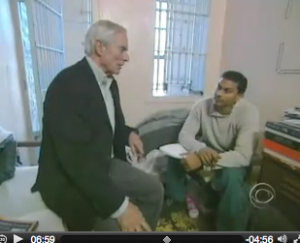The United States currently is the country with the highest number of inmates in prison. Although America is successful in putting criminals away problems occur upon release. Half of those incarcerated end up returning to prison for committing another crime (Olian). To reduce crime, and at the same time cut the number of Americans incarcerated, there must be a push for prison reform, with a major emphasis on the rehabilitation of prisoners. Providing convicted criminals the gift of education, while imprisoned, has been controversial for many years. But attaining a higher education is an extraordinarily beneficial part of prison life, if only to end the vicious cycle of recidivism. In New York State there are a few thriving education programs in correctional facilities. How and why have the opportunities for higher education in New York State prisons changed from 1965 to current day?
The educational opportunities available for inmates in the New York State prison system have gone through a tremendous change, a see saw of reform and retrenchment, over the past half century. The changes can be traced to 1965 when legislation was enacted allowing inmates to receive tuition for a college education. This liberal policy was reversed by enactment of the 1994 Violent Crime and Law Enforcement Act. The Act included a section that barred prisoners from applying for Pell Grants, which awarded eligible students college scholarships. This legislation reflected the views of many people who believed it was unfair to grant a college education to convicts when so many of Americans could not afford the costly price of higher education themselves. Prisoner advocates respond by arguing that prisons provide health care and other fundamental human needs to inmates and providing education should be no different (Olian). Since 1994, without the chance to apply for federal funds to pay for a college education, prisoners seeking an education have had to shift their strategy to find education benefits through voluntary programs supported by private organizations. The short sightedness of the ban on federal support for prisoner education is apparent: inmates who take college courses while in prison have a lower rate of recidivism (Lewin). Correctional facility education programs benefit the inmates and society. Additionally prisoners involved in a higher education program are better behaved while in prison therefore less disruptive to prison life (Olian).
The topic of crime was prevalent in politics leading up to the passing of the Violent Crime and Law Enforcement Act signed by President Bill Clinton on September 13th 1994. The initial effort to disqualify prisoners from eligibility for Pell Grants began in 1988 with the Anti-Drug Abuse Act. The act excluded any person who had trafficked or possessed drugs to be eligible to receive a grant. The topic resurfaced in early 1991 after Governor William Weld, the moderate Republican Governor of Massachusetts, received a copy of a speech on the benefits of obtaining a college degree while incarcerated. He denounced the rehabilitation of criminals through education, and asserted in a widely publicized speech that soon individuals who were unable to afford higher education classes would commit a crime to wind up in prison just to be eligible to receive a free education. Governor Weld continued to express his views in national media interviews, most notably on a segment called ‘Prison U.’ on 60 Minutes. Senator Jesse Helms, a conservative of North Carolina, took the position that if prisoners convicted of drug related offense were ineligible for educational benefits, all prisoners should be eliminated as well. Senator Helms proposed an act denying prisoners the right to qualify for a Pell grant on July 30, 1991. His proposal was passed and in 1992 the amendment was attached to the Higher Education Reauthorization Act. Congress then ruled that inmates sentenced to life in prison or given the death penalty were disqualified from receiving a grant for a higher education. The debate over a right to education in correctional facilities continued to be a prominent and controversial subject in 1993 (Page 358). Republican Senator Kay Bailey Hutchison of Texas was a strong voice calling for the elimination of prisoner eligibility for Pell grants (Phillips). Senator Hutchison presented Senate Amendment 1158 to end prisoner eligibility for receiving Pell Grants. The Senate passed the proposal. The controversial subject was portrayed to the American public once again on April 19th 1994 with an NBC Dateline episode titled ‘Society’s Debt?’ dedicated to the contrast between low-income students that are denied a Pell Grant and inmates who are extended a grant while in prison. The episodes illustrated a heart wrenching story of the father of a thirteen-year-old murder victim as he expresses his fury over the fact that his son’s killer received a Pell Grant, “He’s going to do about 14-and-a-half-years minimum, and we’re saying to him, “Thank you very much for killing somebody. We’re going to give you a college education.”” Just a day after the episode aired, an amendment to exclude all prisoners from receiving a Pell Grant was proposed by Representatives Tim Holden and Bart Gordon of Pennsylvania and Jack Fields of Texas (Page 359). On September 13th 1994 prisoners were officially eliminated as acceptable applicants in receiving a Pell Grant with the signing into effect of the greater Violent Crime Control and Law Enforcement Act (Phillips). By excluding prisoners to receive a grant for a higher education, politicians were playing to popular sentiment. They claimed to be supporters of families who were unable to afford the high price of a college education even though they had played by the rules and had broken no laws. These families faced the frustration that prisoners had the opportunity to higher education that they as law-abiding citizens did not (Page 373). Politicians, and the public at large, responded to these feelings.
Prior to 1965 only a scarce number of educational programs were offered in correctional facilities. In 1965 an act went into effect giving prisoners the choice to apply for Pell Grants. The financial aid given by Pell Grants supported education programs in 90% of the states, including New York, although only one tenth of one percent of the total grants distributed were awarded to prisoners (Martin). The 1970s were considered to be the Golden Age for education in correctional facilities. There was a wide belief in the era that education was the key in empowering prisoners to become valuable citizens. By giving a new meaning to the life of an individual once involved in criminal activity reduces the risk of recidivism. The following decade of the 1980s did not receive the same kind of support for correctional education that the 1970s did. Correctional theories on prison changed during this time from a place of rehabilitation to a place of punishment. In correlation to this difference of belief there were cutbacks in prison education. Although participating in educational programs was the choice of each prisoner, there was a push at the time for mandatory participation (Ryan and McCabe).
In 1994 education in correctional facilities shifted immensely when Congress passed the Violent Crime and Law Enforcement Act. The 1994 Act changed the nature of the prison correctional system drastically as programs instantly began to shut down (Martin). Correctional facilities suffered with the loss of Pell Grants thus creating many cutbacks for education programs. Some states had no choice but to shut down their programs. In fact one report concluded that in 1994-1995 the number of federal prisons offering education programs was 82.6% and a year later dropped to 63% (Ubah and Robinson 124). The availability of choices in the programs decreased with the cut in funding (Ubah and Robinson 125).
Although current programs do not possess the strength they did prior to 1994, through volunteers and private funding they are gaining popularity again. The funding to keep the education program alive is weak. Yet these programs hold enormous potential. Not only does the lack of support for correctional education hurt the prisoners, it hurts society as well. This is due to the correspondence between recidivism and receiving a higher education. A study for the United States Department of Education reported that inmates who obtain an education while in prison are far less likely to commit another crime within the first three years of being released (Lewin). A lead author of the study from the Correctional Education Association, Stephen J. Steurer, explains that not only is the decrease in recidivism of great importance to public safety but also has financial advantages. Steurer is quoted in a 2001 New York Times article explaining the benefits, “”But there are also real financial savings. We found that for every dollar you spend on education, you save two dollars by avoiding the cost of re-incarceration.””(Lewin).
Although focused on college programs there are many other education programs that can be offered in New York State prisons. These include Academic Outreach (Cell Study), Adult Basic Education, Bilingual Program, Certificate in Ministry and Human Services, General Education Development (GED), Masters of Professional Studies, Special Education Program, and Title I Program. In New York there are twenty prisons that offer college programs. (Program Services-Education (Academics)) There are 70 prisons in New York as well as a drug treatment campus, which means in New York State less than 30% of facilities offer secondary education opportunities (New York State, Citizen Guide). In these facilities college level courses are offered to inmates who have already received their high school diploma or a GED. Because of the 1994 Act, prison educational programs are now privately funded. These programs offer inmates a chance to receive certificates, Bachelor, and Associate degrees. Overall program lengths, assessment, and admission requirements vary by the school within the facility. (Program Services-Education (Academics))
Many colleges, including Bard College and Cornell University, work on a volunteer basis made possible by private funds to educate prisoners. At Cornell University, after the 1994 Violent Crime Control and Law Enforcement Act passed which caused taxpayer-funded education programs to deteriorate, faculty members took action. In 1999 Cornell University gave permission for the classes they offered at Auburn Correctional Facility through the efforts of volunteers, to be allowed to count towards college credits for the student-prisoners. Since then Cornell has worked to successfully strengthen the program offering twelve courses each semester taught by faculty or graduate students who offer their time to educate inmates. In 2009 the Sunshine Lady Foundation and the Provost’s office made a generous donation effecting in the programs expansion. The academic opportunities given to the participating prisoners allow them a mental escape from the stark lives that prison life entails. The courses offered through the program range from a class on Shakespeare to one on the Representation of Hip-Hop & Political Thought (Cornell Prison Education Program).

At Bard College in Annandale-on-Hudson, New York a liberal arts education is offered to inmates at the maximum-security prison of Eastern Correctional Facility in New York. Because the Bard Prison Initiative is privately funded the program is free of charge to those admitted. The prisoners of the facility have been sentenced seven years to life for the conviction of heinous crimes. Yet, as seen on the Bard Prison Initiative 60 Minutes special, when placed in a classroom the men are seen as hard working students dedicated to their liberal arts education. The liberal arts curriculum offers many courses including literature, German, sociology and philosophy. One student of the program proudly explained that he must study at least five or six hours in order to be prepared for the stimulating classes he attends through the prestigious liberal arts college. Through the passionate way one inmate speaks it is evident that education has had a transforming effect on him. After taking a course in Philosophy he pushed for a German course to be offered with the hopes he could read the original works of German philosophy. Ironically, the man who is so passionate about philosophers such as Karl Marx will also be spending twenty to forty years of his life behind bars for the fatal shooting of a woman as he committed a robbery. Yet with the help of the Bard Prison Initiative his time spent in prison aims to rehabilitate him by enhancing his life behind bars and hopefully creating a beneficial member of society upon his release. Another student prisoner explains the importance of attaining a higher education rather than vocational training, “A vocational program might give you skills to have a job but it won’t give you skills to have a life”. This same prisoner tragically took the life of his own mother in 1991. In order to end recidivism intensive change must happen during incarceration. A third student prisoner claims until he was locked up he had never read a book; he now strives to get his PhD. Although only about 10% of inmates who apply to receive a Bard Education are extended the opportunity, those who do are extremely grateful. Bard Professor Tabetha Ewing teaches a history course for both Bard students and the maximum-security prisoners. She recounts her first class at the prison positively: “As soon as we shut the door and we began working it was the most amazing experience”. The students fortunate to take Professor Ewing’s European History course were among the hardest working she had encountered; in fact she had to toughen the course to adapt to her students from the Eastern Correctional Facility. Prisoners who choose to participate in the Bard program are given access to a study room. Yet many participants must work in their own rooms, an arduous task due to the constant distractions of prison life (Olian).
Works Cited
“Cornell Prison Education Program.” Cornell Prison Education Program. Cornell
University. <http://cpep.cornell.edu/_Home>.
Lewin, Tamar. “Inmate Education Is Found To Lower Risk of New Arrest.” The New
York Times. The New York Times, 16 Nov. 2001. Web.
<http://www.nytimes.com/2001/11/16/us/inmate-education-is-found-to-
lower-risk-of-new-arrest.html>.
Martin, Marlene. “What Happened to Prison Education Programs?” Socialistworker.org.
July 2009. Web. <http://socialistworker.org/2009/06/02/what-happened-to-prison-
education>.
“New York State | Citizen Guide.” New York State | Citizen Guide. Web. 16 Apr. 2013.
<http://www.nysegov.com/citguide.cfm?ques_id=548>.
Olian, Catherine, prod. “60 Minutes.” Maximum Security Education. CBS. New York,
15 Apr. 2007. Bpi.bard.edu. Bard College. Web. <http://bpi.bard.edu/60-
minutes/>.
Page, Joshua. “Eliminating the Enemy: The Import of Denying Prisoners Access to
Higher Education in Clinton’s America.” Punishment & Society 357-378 6.4 (2004): SAGE Journals. Web. <http://pun.sagepub.com/content/6/4/357>.
Phillips, Leslie. “Crime Bill May Close Book on Inmate Grants.”
USA Today 14 Apr. 1994, Final ed. USA Today.
Gannett Company, Inc.
“Program Services-Education (Academics).” NYS Department of Corrections and
Community Supervision. NYS Department of Corrections and Community
Supervision Web. <http://www.doccs.ny.gov/ProgramServices/academic.html>.
Roberts, Sam. “As Crime Rate Drops, New York’s Jail Population Falls to Lowest Level
in 24 Years.” The New York Times. The New York Times, 11 June 2010. <http://www.nytimes.com/2010/06/11/nyregion/11jails.html?_r=0>.
Ryan, T.A, and Kimberly A. McCabe. “Mandatory Versus Voluntary Prison Education
and Academic Achievement.” The Prison Journal 4th ser. 74 (1994): 450-61.
Sage Publications, Inc. Web. 15 Apr.
2013.<http://tpj.sagepub.com/content/74/4/450>.
Ubah, Charles B.A., and Robert L. Robinson, Jr. “A Grounded Look at the Debate
Over Prison-Based Education: Optimistic Theory Versus Pessimistic
Worldview.” The Prison Journal 83.2 (2003): 115-29. SAGE. Web. 2 May
2013. <http://tpj.sagepub.com/content/83/2/115>.

